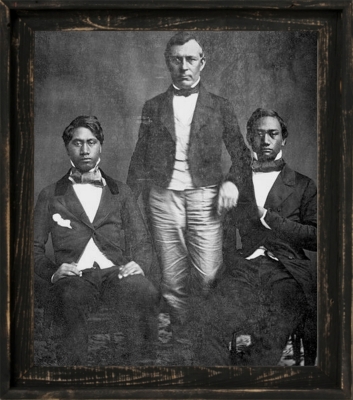 Gerrit Parmele Judd and the "heathens": Princes Alexander 'Iolani Liholiho Keawenu (later Kamehameha IV) and Lot Kapuaiwa (later Kamehameha V), 1850 |
No missionaries had yet come to the Sandwich islands; and, in truth, they could promise themselves but little fruit among this sensual people. Christianity cannot be established in Eastern Polynesia, but on the overthrow of every thing existing.
[Adelbert von Chamisso from the Russian expedition on the Rurick]
[Adelbert von Chamisso from the Russian expedition on the Rurick]
Ahupua'a [a subdivision of island land]: from the uka, mountain, whence came wood, kapa, for clothing, olona, for fish-line, ti-leaf for wrapping paper, ie for rattan lashing, wild birds for food, to the kai, sea, whence came ia,fish, and all connected werewith.
[quote from land surveyor and missionary's son, Curtis Lyons, as quoted in Shoal of Time by Gavan Daws]
[quote from land surveyor and missionary's son, Curtis Lyons, as quoted in Shoal of Time by Gavan Daws]
It is a fact well known to me that since I came to the Islands the Government have depended on individuals of the Mission for advice on all important
measures and for aid in carrying them into execution.
[In letter from Gerrit Parmele Judd in 1843 as quoted in The Hawaiian Kingdom, 1778-1854 by Ralph Simpson Kuykendall]
[In letter from Gerrit Parmele Judd in 1843 as quoted in The Hawaiian Kingdom, 1778-1854 by Ralph Simpson Kuykendall]
You must know that I am at present the King Bingham of the Sandwich Islands.
[In letter from Gerrit Parmele Judd to a friend in Boston, 1845, as quoted in To Steal a Kingdom by Michael Dougherty]
[In letter from Gerrit Parmele Judd to a friend in Boston, 1845, as quoted in To Steal a Kingdom by Michael Dougherty]
Whereas Kamehameha had used foreign advisers to aid his own goals while furthering the desire to protect and strengthen Native traditions, after he left the scene, his successors came to be dominated by Protestant missionaries. The missionaries of the American Board of Commissioners for Foreign Missions (ABCFM; Congregational Church now the United Church of Christ) from New England disdained Hawaiian culture for religious and secular reasons and insinuated themselves on the Hawaiian royalty to spread their faith. The strength and breadth of their impact was fortuitous because they were numerous, resident and devised a writing system to aid in their conversion. As such they were natural teachers and translators. Because the foundation of their message was unified, they were stronger than earlier advisers. Meanwhile, the population of Native Hawaiians was being decimated by diseases introduced by the foreigners more broadly. Over the course of the nineteenth century, the Native Hawaiian population would dwindle while their culture would become subverted to American culture. The conversion of Native Hawaiians never led to them to become full partners in the new, capitalist culture that was imposed on them. So while over the nineteenth century their population continued to diminish, the survivors were increasingly disenfranchised and impoverished on their own islands.
Five months after King Kamehameha died, a group of 17 Protestant Missionaries from New England, including Hiram Bingham, Asa Thurston and their new wives set sail on the brig Thaddeus for Hawai'i. Bingham recorded his first impressions upon arriving at the "Darken heathen shores" of Honolulu on April 19, 1820, which serve as a striking contrast to Cook and other explorers:
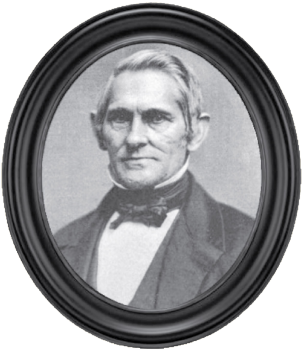 Hiram Bingham later in life |
A first sight of these wretched creatures was almost overwhelming. Their naked figures and wild expression of countenance--their black hair, streaming in the wind, as they hurried the canoe over the water, with all the eager action and muscular power of savages--their rapid and unintelligible exclamations, and whole exhibition of uncivilized character, gave to them the appearance of half-man and half-beast. and irresistibly pressed on the thoughts the query--'Can they be men--Can they be women!--do they not form a link in creature, connecting man with brute?
There is not a little bit of hyperbole in this description of their landing in Hawai'i. Bingham and Thurston had, after all, been sponsored by the ABCFM which had given religious training to several Hawaiian youths brought to the East Coast by merchant vessels. What was not exaggerated, though, is his missionary zeal which was inextricably tied to his disdain for the Kingdom of Hawai'i, "a rude, dark, vile part of the world," its people and their culture. He criticized hula dancers, for example, arguing that:
While some of the people who sat in the darkness were beginning to turn their eyes to the light, and were disposed to attend our schools and public lectures, others, with greater enthusiasm, were wasting their time in learning, practising, or witnessing the hula, or heathen dance and song....
Melody and harmony are scarcely known to them, with all their skill and art. The whole arrangement and process of their old hulas were designed to promote lasciviousness, and of course the practice of them could not flourish in modest communities. They had been interwoven too with their superstitions, and made subservient to the honor of their gods, and their rulers, rather living or departed and deified.
Acknowledging that swimming, diving, surfing and canoeing were “the favorite amusement of all classes” of the early Hawaiians he easily foresaw how this part of their culture was under fire from his own work of civilizing the heathen:
The adoption of our costume greatly diminishes their practice of swimming and sporting in the surf, for it is less convenient to wear it in the water than a native girdle, and less decorous and safe to lay it entirely off on every occasion they find for a plunge or swim or surf-board race. Less time, moreover, is found for amusement by those who earn or make cloth-garments for themselves like the more civilized nations.
By July, missionaries from this first contingent of the ABCFM were settled on the three most populous islands of O'ahu, Hawai'i and Maui. In June of the next year, Ka'ahumanu's attack on the Native Hawaiian religion continued with the burning of 10 wooden representations of gods early in the month followed by the burning of 102 more, which she had ordered gathered together, later in the month. If the missionaries had any doubts, now there were none. The most effective way to convert the masses was to convert their leaders. Bingham's target was Ka'ahumanu. After a year of persistent proselytizing, in December 1821, Bingham and his wife Sybil's prayers at the side of Ka'ahumanu through a life-threatening illness paid off:
She was soon restored, and with her friends set a higher value on the religion which we were endeavouring to inculcate. There was from this period a marked difference in her demeanor towards the missionaries, which became more and more striking, tell we were allowed to acknowledge her as a disciple of the Divine Master.
A few years later at a council of the Kingdom of Hawai'i's chiefs held in Honolulu after Kamehameha II's burial in 1825, which Lord Byron as emissary from the British Government attended, Hiram Bingham, speaking on behalf of the missionaries, told the chiefs that the missionaries had no intention of interfering in Hawaiian politics or commerce. This was a deceptive comment as his mere presence at the meeting was evidence to the contrary. Meanwhile, missionary children were kept apart from Native Hawaiians and sent to the United States to be educated. After 1841, they were sent
to Punahou School established in Honolulu where they were cloistered in such a way that nurtured the contempt their parents possessed for the Native Hawaiians (Punahou was later opened up to non-missionary children). For the rest of the century, missionaries of the ABCFM, their children and those connected to the Punahou School, though only 906 students passed through their doors until 1898, would be in the forefront and directly involved in political activities directed at the shifting of power, land and commerce away from the Native Hawaiians to the haoles.
In spite of Kamehameha II's faults and the changes to early Hawaiian culture that the kuhina nui, Ka'ahumanu, had orchestrated, the status quo remained more or less the same until he died. His successor was his younger brother, Kauikeaouli, who began his rule at the young age of 13 as Kamehameha III with Ka'ahumanu continuing on as kuhina nui.
The proclamation of new laws readily showed the influence of the missionaries as they were all laws of morality: in 1827, there were laws against murder, theft and adultery; and in 1829 added were: "fornication, retailing ardent spirits at houses of selling spirits, amusements of the Sabbath day, gambling and betting on the Sabbath day and all times." Ironically, these laws seem to be aimed primarily at foreigners, largely sailors rather than the Native Hawaiians, who presumably were able to address violations of social rules as always though foreign morays were obviously making inroads particularly as regards sexual intercourse. And yet traditional arts faced increasing restrictions as well. Public performances of the hula were banned in 1830.
A French mission aboard the Cometè which carried three Catholic missionaries and lay persons arrived at Honolulu in 1827 and had in two years converted some 69 adults plus children. In competition with Catholic missionaries in Tahiti and fearful that they would make inroads in the Kingdom, Protestant missionaries retaliated by ensuring the Catholic missionaries were deported in 1831 and Catholics on the islands in general were persecuted.
Ka'ahumanu died in 1832 when the king was 19, and overnight, according to Michael Dougherty, he became “a liberated hedonist, outshining his late brother Liholiho in horse racing, card playing, woman chasing and rum drinking." Due largely to such oepn defiance for the strictures previously imposed under Ka'ahumanu there was some easing on them in general. Still the hula, for example, faced various restrictions until the mid-1880s when a revival was sponsored under the elected king, David Kalakaua.
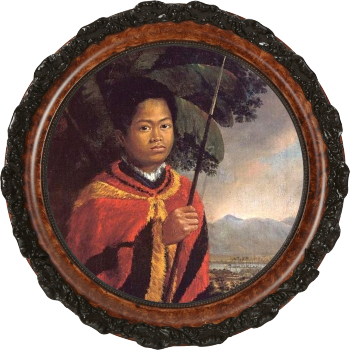 Kamehameha III |
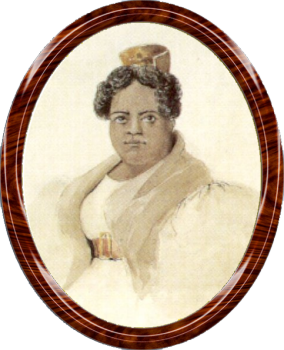 Kina'u |
In losing the kuhina nui, ambitious ABCFM missionaries had lost their greatest sponsor so they approached one of Kamehameha II's wives, Kina'u, who was also his half sister (her mother was of lesser rank than the king's), and according to missionary Gerrit Parmele Judd, "our arguments convinced her. By our advice, she presented herself to the king and claimed her rights, which were acknowledged, and she was in due time proclaimed as Kuhina." She took the name Ka'ahumanu II to both give her the élan of legitimacy and make clear to everyone
whose side she was on.
The early doyen of Hawaiian history and scholar at UH Mânoa, Ralph Simpson Kuykendall, whose monumental three-volume history of Hawai'i written between 1938 and 1967 (though based initially on a single volume published earlier in 1925; and the third volume here was published posthumously because he died in 1963) initiated the push of the territory-then state's historiography beyond the confines of the missionary perspective to include other archival materials though as time passes he appears increasingly as an apologist for the missionaries and commercial concerns. Still, he wrote in an era when public rhetoric was conservative and dominated by the Big Five commercial interests on the islands whose origins dated back to the first half of the prior century.
Kuykendall argues increasing foreign commercial trade, particularly with Americans, necessitated that the Hawaiian rulers begin to formulate laws, and by extension, a government that the American and European traders could effectively understand, have confidence in and anticipate. But this is only true in so much as the early Hawaiians were pushed by foreign trade. They were not. Instead it was the missionaries and, later, commercial interests, who pushed the needs of the islands to suit themselves. After all, the Native Hawaiians had for more than 40 years since Cook's discovery succeeded without a need for a foreign form of government so Kuykendall's argument is ex post facto. It is true that Kamehameha had built up his military resources to first unite the islands and then, with intent to both maintain the union as well as to protect against errant foreign aggressions, but there was never a serious concern of a large-scale invasion for which the Hawaiians were unlikely to have the capacity to counter until they manufactured armaments themselves. The real difference was between the rulers
and their foreign advisers.
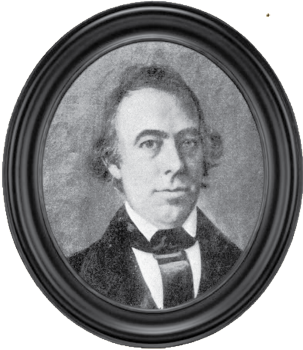 William Richards |
The ABCFM actually had a precept which denounced mixing religion and politics: "The Kingdom of Christ is not of this world, and it especially behooves a missionary to stand aloof from the private and transient interests of chiefs and rulers." So when their missionary, William Richards, who had served in Laihana, Maui for 15 years accepted an appointment as "chaplain, teacher and translator" to King Kamehameha III in 1838, the ABCFM forced him to resign from the mission. Richards was the architect for the Declaration of Rights (1839) and Constitution of 1840, both of which would have been completely foreign in form and substance to Hawaiians a generation earlier. These documents acknowledged the supremacy of God/Jehovah. The Rights protected individuals, their property and (with a New England Puritanical nuance) productions, and provided that chiefs should be removed if they violated these rights. The Constitution, in creating a premier, House of Nobles, representative body and courts, made the King subservient to the law. The Kingdom was effectively no more--Hawai'i was now a constitutional monarchy. While there would be many more Hawaiian constitutions created through the rest of the 19th century, the basic principles of this one remain today, with two exceptions, constitutional changes in 1887 and 1893 when the monarch's powers were sharply curtailed and then the monarch was overthrown.
In 1842, William Richards was appointed by the Kamehameha III to go on a mission to Europe. At this time, the ABCFM requested another missionary, Gerrit Parmele Judd, to replace Richards in Lahaina. Judd, who had helped found the Punahou School with Hiram Bingham, was more interested in replacing Richards in his positions in government and resigned from the mission instead. In addition to replacing Richards in 1842 as translator, he was appointed recorder, a member of the treasury board, authorized to assist the governor of O'ahu in “all business of importance between foreigners”; and Minister of Interior from 1845 to 1846 and Minister of the Finance from 1846 to 1853. In these positions he did more for the haoles in Hawai'i than has ever been done by one man before or since.
Judd's influence was primarily in two areas, placing haoles, particularly those who supported his views, in important government positions and orchestrating a massive reorganization of land tenure in Hawai'i. Judd set an impression of imperiousness early on, according to Dougherty. He ordered a coat of arms designed in Paris, which Kamehameha III presented him in a public ceremony, yet this did not satisfy the former missionary:
When Judd appeared at official functions attired in a vivid blue coat with gold insignia, white vest and trousers and the plumed hat of a field marshal, he regularly received 17-gun salutes as he alighted from his gilt-encrusted, plush brocade coach, which once carried Queen Victoria.
Now properly accoutered, Judd set about to form his government in the name of the King:
It was easy to see that the foreigner could never consent to be ruled entirely by the native, and with the full concurrence of the King I adopted the plan of employing foreigners and required all who wanted land or other favors to take the oath of allegiance to the King. This system soon produced its effects and by the time Mr. Richards returned we had a dozen of the best foreigners in office as ministers, councilors, judges, collectors, etc. Over time, Judd's appointments mushroomed in numbers.
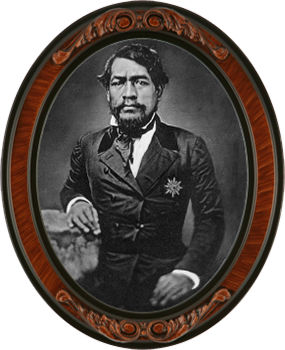 Kamehameha III |
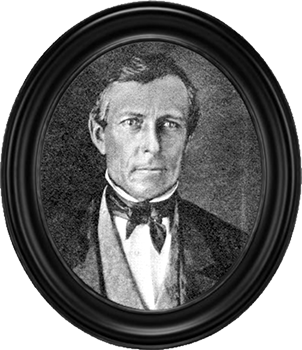 Gerrit Parmele Judd |
Having ensured that the levers of power were firmly in his hands, Judd set about to guarantee that those who shared the values of the Protestant missionaries would have adequate real estate to permanently sow the seeds of Christianity and civilization in the Islands. This was called The Great Mahele, or division of lands, though it was obviously much more. Initially, Judd had sought to clearly record what lands the King and the chiefs owned on the islands. Then he aimed to give some to the state, followed by common Native Hawaiians and lastly to create a viable solution whereby industrious haoles could own land permanently rather than rent it for a clearly demarcated period of time. In itself this would not have been so catastrophic, but the manner in which it was carried out and who was ultimately left with the land would make it so.
In a typewritten document from circa 1888 found at the University of California, Berkeley's Bancroft Library whose authorship is not listed*, the missionaries, here referred to more broadly as "the foreigners"'s explanation for the need for land reform is explained:
What the king or the chiefs said was to be, had to be; there was no question about it. It was in the power of the chief to turn the people away from the land, or to take from them almost anything they possessed. To this foreigners attributed a good deal of the improvidence and idleness, and want of thrift among the people, and thought if the people could have the benefit of their own labor and its earnings, they would become more industrious, and make better homes form themselves, etc. note
The catalogue entry for this document, Data regarding the Hawaiian Islands : typescript, [ca. 1888] , gives William Lee as the creator, though it clearly states that Lee had been dead since 1857 and the document covers events which occurred in the 1880s.. It is highly likely that the author was missionary scion, William De Witt Alexander, who served on Berkeley's faculy.
Dougherty, who best captures Judd's land grab, explains that members of the ABCFM gained 7,888 prime acres on O'ahu, in part because the government permitted missionaries who had served eight years in Hawai'i and owned less than 500 acres of land to purchase land at a reduced rate. Judd did better than most, gaining at least 5,295 acres across the Kingdom. By comparison, approximately 8,750 Native Hawaiians received 28,600 acres, or 3.27 acres each on average. Keep in mind that Native Hawaiians comprised 91.75% (71,019) of the population and Non-Native Hawaiians a mere 2.9%
(2,119, predominantly whites) in 1853 by which time most of the Mahele had been instituted. Vested with the ability to purchase and own land permanently and installed in the levers of power, haoles rapidly took over. By the end of the 19th century, haole men owned four acres for every one owned by a Native Hawaiian.